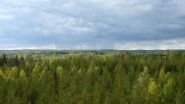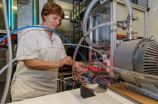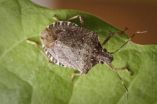(Press-News.org) Helsinki/Jülich/Leipzig. Scientists made an important step in order to better understand the relationships between vegetation and climate. So-called extremely low-volatility organic compounds, which are produced by plants, could be detected for the first time during field and laboratory experiments in Finland and Germany. These organic species contribute to the formation of aerosol that can affect climate and air quality, they report in this week's issue of the journal Nature. The results may help to explain discrepancies between observations and theories about how volatile organic compounds produced by vegetation are converted into atmospheric aerosol – especially over forested regions.
Forests emit large amounts of volatile organic compounds (VOC). Their reaction products form the so-called secondary organic aerosol. In this case, gases are converted into particles that reflect solar radiation or act as nuclei for cloud droplets. These processes have a major influence on the climate and are therefore of special scientific interest. However, the model calculations have been very inaccurate, as there are still large gaps in our knowledge concerning the role of the compounds emitted by plants during the transition between gaseous and solid state. As long as these processes are poorly understood, it is difficult to give accurate predictions. This uncertainty also affects all climate models.
Large uncertainties do primarily exist regarding the growth of newly formed particles towards cloud nuclei on which water condenses, thus initiating the formation of clouds. The particle growth in the diameter range between about three and one hundred nanometers requires low-volatile organic vapors, as has been speculated. These "extremely low-volatility organic compounds (ELVOC)" have been hardly detected so far and their possible formation pathways are very speculative. Latest progress in the measurement techniques made their detection possible. Until recently, these compounds could not be measured because they are very short-lived. As soon as these molecules collide with a surfaces, they remain adsorbed and cannot be detected in the gas phase by analytical instruments. To prevent this, the ELVOCs are directly ionized under atmospheric conditions in the gas phase, and subsequently transported as an electrically charged ELVOC-molecule into the sensor (mass spectrometer), where the detection takes place. This powerful analytical method using mass spectrometric detection is called CI-APi-TOF (chemical ionization - atmospheric pressure interface time -of-flight mass spectrometry).
The newly released study by scientists from Finland, Germany, the USA and Denmark consists of several parts. The field measurements were carried out at the station of the University of Helsinki in Hyytiäla in southern Finland, which is typical for boreal forests, which cover eight percent of the earth's surface. The main part of the study comprises laboratory investigations performed in a reaction chamber at the Research Center Jülich. The Jülich Plant Atmosphere Chamber (JPAC) is a 1.5-cubic-meter glass chamber under controlled conditions of temperature, humidity and irradiation. "We have focused our efforts on the oxidation of α-pinene, because it accounts for about half of global monoterpene emissions," explains Dr. Mikael Ehn from the University of Helsinki, who is the first author of this study and did the pioneering work for the discovering of ELVOCs. Every forest visitor can recognize these compounds as the typical fir needle smell. "We managed to present the first molecular evidence of a direct and ubiquitous source of ELVOCs arising from the oxidation of monoterpenes and other volatile organic compounds in the gas phase." This produces vapors with relatively large molecules containing many hydrogen atoms as well as approximately the same number of oxygen as carbon atoms. "The results suggest that about 10 percent of the reacting VOC mass is converted tosecondary organic aerosol over the tree tops. Previous estimates were based on a share of less than 5 percent. This shows that the role of ozone (the oxidant of α-pinene and other monoterpenes) has been underestimated. There is still quite large uncertainty in climate models at this point," the lead author states. Mikael Ehn has been working on this study over four years and is glad that the international cooperation in the large team has made it possible not only to detect these new compounds but also to explain the mechanism that leads to the formation.
Measurements in the chemistry laboratory of the Leibniz Institute for Tropospheric Research (TROPOS) in Leipzig have also contributed to this result. The researchers let the needle scent α-pinene react with both "normal" ozone (16O3) and "labeled", heavier ozone (18O3), in order to determine the portion of heavy oxygen atoms (18O) in the formed ELVOCs. "These experiments allowed us a first insight into the formation mechanism of these compounds and provide the basis for a series of further experiments," as Dr. Torsten Berndt from TROPOS explains. Chemists from TROPOS investigate reactions of OH and other radicals since many years. The hydroxyl radical consisting of one hydrogen and one oxygen atom, is one of the most common free radicals in the air and is therefore often referred as the detergent of the atmosphere.
The new findings help to explain a significant part of the organic mass of aerosol particles in the air, which had remained mysterious to the scientists so far. Changes in the ratio of ozone to OH radicals could be an additional anthropogenic influence on the atmosphere. The formation of the new ELVOCs influences cloud formation and hence the climate, the scientists conclude. The new findings will help to better estimate different land use effects and especially the effects of vegetation on the climate . As a result, the climate models can be improved, which had not sufficiently taken into account the growth of nanoparticles caused by these compounds produced in boreal regions.
INFORMATION:
Publication:
Mikael Ehn, Joel A. Thornton, Einhard Kleist, Mikko Sipila, Heikki Junninen, Iida Pullinen, Monika Springer, Florian Rubach, Ralf Tillmann, Ben Lee, Felipe Lopez-Hilfiker, Stefanie Andres, Ismail-Hakki Acir, Matti Rissanen, Tuija Jokinen, Siegfried Schobesberger, Juha Kangasluoma, Jenni Kontkanen, Tuomo Nieminen, Theo Kurtén, Lasse B. Nielsen, Solvejg Jørgensen, Henrik G. Kjaergaard, Manjula Canagaratna, Miikka Dal Maso, Torsten Berndt, Tuukka Petäjä, Andreas Wahner, Veli-Matti Kerminen, Markku Kulmala, Douglas R. Worsnop, Jürgen Wildt & Thomas F. Mentel (2014): A large source of low-volatility secondary organic aerosol. Nature, 506, 476-479. 27 February 2014.
http://www.nature.com/doifinder/10.1038/nature13032
The research was funded by the Emil Aaltonen foundation, the US Department of Energy Office of Science, the European Research Council (ATMNUCLE), the European Commission (PEGASOS) and the Academy of Finland Center of Excellence.
Further information:
Dr. Mikael Kristian Ehn (en. + fi.)
University of Helsinki
https://tuhat.halvi.helsinki.fi/portal/en/persons/mikael-kristian-ehn%280f9f7088-93e0-457a-863c-969037a64ebf%29.html
and
Dr. Torsten Berndt, Prof. Hartmut Herrmann
Leibniz Institute for Tropospheric Research (TROPOS)
phone +49-341-2717-7032, -7024
http://www.tropos.de/en/institute/about-us/employees/
http://www.tropos.de/en/institute/departments/chemistry/
or
Tilo Arnhold, TROPOS Public Relations
phone +49-341-2717-7060
http://www.tropos.de/en/institute/about-us/employees/
links:
Centre of Excellence in Atmospheric Science – From Molecular and Biological processes to The Global Climate
SMEAR II station of the University of Helsinki in Hyytiäla
Jülich Plant Atmosphere Chamber (JPAC)
Laboratory investigations on particle formation and early growth at TROPOS:
http://www.tropos.de/en/research/atmospheric-aerosols/process-studies-on-small-spacial-and-temporal-scales/secondary-aerosol-formation/new-particle-formation-nucleation/laboratory-investigations-on-particle-formation-and-early-growth/
older press releases:
Plants moderate climate warming (Press release, 28-Apr-2013)
in German:
http://www.tropos.de/aktuelles/pressemitteilungen/details/pflanzen-bremsen-die-klimaerwaermung/
A new atmospherically relevant oxidant of sulphur dioxide - Nature (press release, 08 August 2012):
http://www.colorado.edu/news/releases/2012/08/08/cu-led-team-discovers-new-atmospheric-compound-tied-climate-change-and
in German:
http://www.tropos.de/aktuelles/pressemitteilungen/details/nature-neues-oxidationsmittel-der-atmosphaere-entdeckt-das-luftschad/
New gas-phase compounds form organic particle ingredients
2014-02-26
ELSE PRESS RELEASES FROM THIS DATE:
Antidote can deactivate new form of heparin
2014-02-26
Low-molecular-weight heparin is commonly used in surgeries to prevent dangerous blood clots. But when patients experience the other extreme – uncontrolled bleeding – in response to low-molecular-weight heparin, there is no antidote.
Now researchers at the University of North Carolina at Chapel Hill and Rensselaer Polytechnic Institute have created a synthetic form of low-molecular-weight heparin that can be reversed if things go wrong and would be safer for patients with poor kidney function.
"When doctors talk to me about the kind of heparin they want to use during ...
Surge in designer drugs, tainted 'E' poses lethal risks
2014-02-26
In the span of a decade, Canada has gone from ecstasy importer to global supplier of the illegal party drug. At the same time, even newer designer highs—sometimes just a mouse-click away—are flooding the drug market faster than legislation can keep pace.
It's a worrying problem that University of Alberta researchers say requires more education to help Canadians understand the very real, deadly risks of designer drug use.
"The chemists who are making these drugs are coming up with about 10 new drugs per year; the legislation cannot keep up with the market," said Alan ...
Study shows why breastfed babies are so smart
2014-02-26
Loads of studies over the years have shown that children who were breastfed score higher on IQ tests and perform better in school, but the reason why remained unclear.
Is it the mother-baby bonding time, something in the milk itself or some unseen attribute of mothers who breastfeed their babies?
Now a new study by sociologists at Brigham Young University pinpoints two parenting skills as the real source of this cognitive boost: Responding to children's emotional cues and reading to children starting at 9 months of age. Breastfeeding mothers tend to do both of those ...
Still-fresh remnants of Exxon Valdez oil protected by boulders
2014-02-26
HONOLULU – Twenty-five years after the infamous Exxon Valdez oil spill in Prince William Sound, beaches on the Alaska Peninsula hundreds of kilometers from the incident still harbor small hidden pockets of surprisingly unchanged oil, according to new research being presented here today.
The focus of the study is to learn how oil persists long after a spill. Researchers presenting the work caution that the amount of oil being studied is a trace of what was originally spilled and that results from these sites cannot be simply extrapolated to the entire spill area.
The ...
Fox Chase researchers discover new mechanism of gene regulation
2014-02-26
In the cells of humans and other organisms, only a subset of genes are active at any given time, depending largely on the stage of life and the particular duties of the cell. Cells use different molecular mechanisms to orchestrate the activation and deactivation of genes as needed. One central mechanism is an intricate DNA packaging system that either shields genes from activation or exposes them for use.
In this system, the DNA strand, with its genes, is coiled around molecules known as histones, which themselves are assembled into larger entities called nucleosomes. ...
Harvested rainwater harbors pathogens
2014-02-26
South Africa has been financing domestic rainwater harvesting tanks in informal low-income settlements and rural areas in five of that nation's nine provinces. But pathogens inhabit such harvested rainwater, potentially posing a public health hazard, especially for children and immunocompromised individuals, according to a team from the University of Stellenbosch. The research was published ahead of print in Applied and Environmental Microbiology.
International studies had indicated that harvested rainwater frequently harbors pathogens, and that, in light of the financing ...
No warming hiatus for extreme hot temperatures
2014-02-26
Extremely hot temperatures over land have dramatically and unequivocally increased in number and area despite claims that the rise in global average temperatures has slowed over the past 10 to 20 years.
Scientists from the ARC Centre of Excellence for Climate System Science and international colleagues made the finding when they focused their research on the rise of temperatures at the extreme end of the spectrum where impacts are felt the most.
"It quickly became clear, the so-called "hiatus" in global average temperatures did not stop the rise in the number, intensity ...
Beta-catenin alters T cells in lasting and harmful ways
2014-02-26
Activation of beta-catenin, the primary mediator of the ubiquitous Wnt signaling pathway, alters the immune system in lasting and harmful ways, a team of Chicago-based researchers demonstrate in the February 26, 2014, issue of Science Translational Medicine.
An increase in beta-catenin in certain types of T cells—a class of white blood cells—causes chronic inflammation in the intestine and colon, eventually leading to cancer. The same mechanism is used by colon cancer to propagate itself. The researchers combine data from patients suffering from colitis or colon cancer ...
Hubble monitors supernova in nearby galaxy M82
2014-02-26
This is a Hubble Space Telescope composite image of a supernova explosion designated SN 2014J in the galaxy M82. At a distance of approximately 11.5 million light-years from Earth it is the closest supernova of its type discovered in the past few decades. The explosion is categorized as a Type Ia supernova, which is theorized to be triggered in binary systems consisting of a white dwarf and another star — which could be a second white dwarf, a star like our sun, or a giant star.
Astronomers using a ground-based telescope discovered the explosion on January 21, 2014. This ...
Characterization of stink bug saliva proteins opens door to controlling pests
2014-02-26
Brown marmorated stink bugs cause millions of dollars in crop losses across the United States because of the damage their saliva does to plant tissues. Researchers at Penn State have developed methods to extract the insect saliva and identify the major protein components, which could lead to new pest control approaches.
"Until now, essentially nothing was known about the composition of stink bug saliva, which is surprising given the importance of these insects as pests and the fact that their saliva is the primary cause of feeding injury to plants and crop losses," said ...







